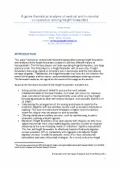-
Past ETC Papers

Browse, search and view papers from the past AET Conferences.
-
Members' Area

AET promotes networking and exchange of ideas, information and opportunities amongst members.
Conference Papers 2012
Glasgow, United Kingdom
ETC Conference Papers 2012
A game theoretical analysis of vertical and horizontal co-operations among freight forwarders
Seminar
Day 2 (9 Oct 2012), Freight & Logistics, UNDERSTANDING MODE CHOICE IN FREIGHT TRANSPORT, 16:00 - 16:00
Status
Accepted, documents submitted
Authors
N Saeed, Molde University College, NO
Short abstract
The objective of this paper is to compare the vertical and horizontal cooperation among freight forwarders.
Abstract
This paper has analysed four cases for three freight forwarders with two different means of transportation.The first two players are truck-operating freight forwarders, one large and one small. The third player is a freight forwarder with its own ship. In the first case, all players work independently and the numerical analysis obtained by solving the Bertrand model reveals that the Nash equilibrium prices are higher for players 1 and 2 ?freight forwarders with their own trucks. However, despite the high price, player 1 captures the largest market share. This reflects users? preference to trucks over ship to carry their cargo, even though ships are cheaper. This could be due to the fact that trucks offer a flexible service with low waiting time. However, the frequency of ships is lower and waiting time is high. Moreover, although player 2 is also a freight forwarding company with its own truck, it is a small company that simply cannot offer services with the same high frequency as a large truck-operating company.
The next three cases discussed different combination of coalitions among these players. A two-stage game was applied for the purpose of analysis. In the first stage, the three players had to decide whether to act alone or to enter into a coalition with another player. The decision at this stage should presumably be based on the predicted outcome for the second stage. Here, the second stage is modelled as a Bertrand game, with one outside competitor and the coalition. The numerical results reveal that all three kinds of coalitions generate higher profits for the members of the coalitions, as well as for outsiders in each case. The reason for the high profit is the high Nash equilibrium prices that players are able to charge from their users due to the creation of a duopoly after the establishment of a coalition among any two players.
Although all combination of coalitions result in higher profit for the players involved. However, the combined profit of the members of coalition, as well as outsiders, is highest in a situation when players 1 and 3 cooperate and offer intermodal services to their users. Due to market power and improved quality of service, these players are able to charge higher prices. Therefore, according to these findings, it is more beneficial to establish a vertical cooperation between a large truck operator and a ship operator to offer intermodal services than to establish a horizontal cooperation between two players. Moreover, establishing vertical cooperation among a small trucking company and a ship operator is also not as beneficial as the previously mentioned vertical cooperation.
However, calculations of users? surplus show that these kinds of coalitions are not beneficial for users because they generate a negative payoff for them, which reflects the high prices they will have to pay to the service providers.
Documents:

Association For
European Transport
Forester House
Doctors Lane
Henley-in-Arden
Warwickshire, UK
B95 5AW
+44 (0) 15 64 793552
VAT number: 710 1866 64
Conference Supporters & Endorsers




Legal Entity
The Association for European Transport is registered as an Association ('vereniging') with the Chamber of Commerce for Haaglanden in The Netherlands under company number 27170096.
Built on Zenario




